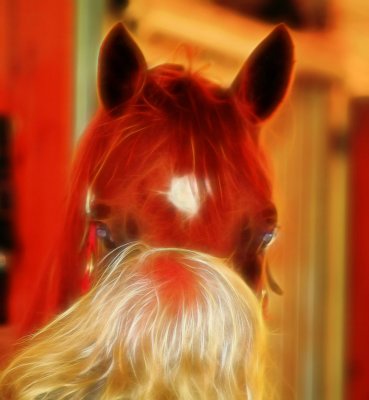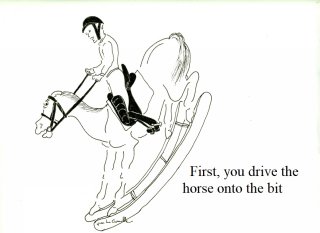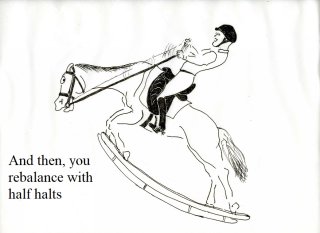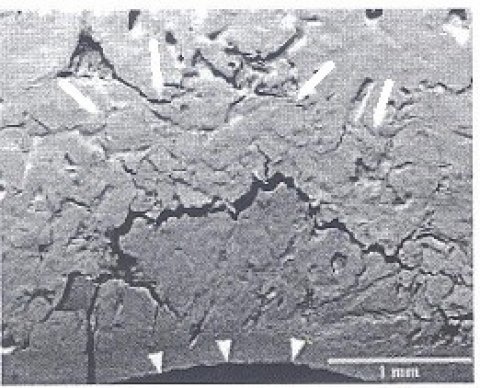Thinking
The horse is already plenty smart,
it is our turn to think.

“Penser est une joie profonde.”
(Michel Serres)
(Thinking is a profound joy.)
Thinking while riding is a profound joy as long as the dialogue is about partnership instead of submission. Since humans realized that they could climb onto the back of equines, equines have willingly performed moves for which their physique was not adequately prepared. As humans see animals, including equines, through their myopic lens of self-importance, they regard equine performances as a due. Humans conveniently decided that performances were the outcome of natural reflexes.
Practically, until Etienne Jules Marey who pioneered, at the end of the nineteenth centuries, the mechanical analysis of locomotion, the methodologies of equine education were based on visual observations and feeling. They were repeated from generation to generation without being scientifically substantiated. For instance, the concept of weight transfer, the thought that the horse achieves balance control shifting the weight backward over the haunches, does not have any scientific meaning. Indeed, the belief is contradicted by actual knowledge. The forelegs instead of the hind legs produce the greatest vertical impulse. “In horses, and most
mammalian quadrupeds, 57% of the vertical impulse is applied through the thoracic limbs, and only 43% through the hind limbs.” (H. W. Merkens, H. C. Schamhardt,G. J. van Osch, A. J. van den Bogert, 1993).
In their more recent “Mechanical Analysis of locomotion,” (1998), Liduin S Meershork and Anton van den Bogert, talk about the same horse, but in totally different words. Dynamic phenomenon, unknown to our ancestors, explains equine locomotion and performances in terms and concept foreign to classical views. Traditionally, impact forces are created and absorbed by eccentric contractions and propulsive forces are produced by concentric contractions. In reality, a great part of equine locomotion results from the storage and reuse of elastic energy. In fact, when the rider evolves from classical knowledge to actual knowledge, the profound joy of the rider’s thoughts creates situations allowing the horse mental processing to reach superior efficiency. If the rider creates a balance, cadence, body alignment and coordination allowing the horse to process greater efficiency, the muscular work of eccentric and concentric contraction can be greatly reduced and replaced by better storage and use of elastic energy. “Power absorption is therefore not always associated with eccentric contraction but can also be caused by elastic energy storage in tendons and ligaments. The subsequent power production can originate from the release of elastic energy instead of concentric muscle contraction.” (Liduin S. Meerrshoek and Anton J. van den Bogert. Mechanical Analysis of locomotion, 2003)


Unloading the forelegs is a priority emphasized on and between the line of serious scientific studies. However, traditional thinking dismisses concerns about loading the front legs. Not only does driving the horse forward on a fast motion alter the horse ability to maximize the use of elastic energy, but the misconception also exposes the subchondral bones to microcracks and microfractures, which, if not healed by the bonds remodeling capacity, can migrate into the cartilage of the joint to develop arthritis. The picture is an electronic scanner picture showing a microcrack  which has evolved into a microfracture and has migrated into the cartilage of the joint. Bones are very well capable to heal themselves on the condition that the stress overwhelming the integrity of their structure is no longer acting. This is where, furthering James Rooney’s work, the principles emphasized by the Science of Motion prevents problems before they become an emergency.
which has evolved into a microfracture and has migrated into the cartilage of the joint. Bones are very well capable to heal themselves on the condition that the stress overwhelming the integrity of their structure is no longer acting. This is where, furthering James Rooney’s work, the principles emphasized by the Science of Motion prevents problems before they become an emergency.
At the point illustrated by this scanner picture, it is too late, but the evolution of the damage within the subchondral bone could have been halted before it migrated into the cartilages of the joint. The solution, in line with the principles of the Science of Motion, is identify and correct the root cause of the excessive loading. Instead, peripheral industries keep riders in orbit around the problem adding medications to injections to therapies. The teaching of the Science of Motion goes the other way. The science focus on the problem, identifying the source of the kinematics abnormality inducing abnormal stress on the joint and other structures, and corrects it.
Addressing a problem before it becomes an emergency is the test of leadership. “One of the tests of leadership is the ability to recognize a problem before it becomes an emergency.” (Arnold H. Glasgow) A real leader does not force the horse to follow. A real leader invites the horse in a journey. The joy of thinking while riding is inviting the horse to process the body coordination optimally adapted to the effort. It is an intimate dialogue where the horse first attempts is naturally a compromise pleasing the rider while protecting his body state. The outcome is an error that conventional equitation regards as behavior. Instead, if the rider regards the horse “error” as a willing attempt to execute the move while protecting whatever muscle imbalance or morphological flaw hampering the horse’s physique, the horse’s error describes the horse’s actual body situation. If the rider has clearly in mind the body coordination required for the athletic demand of the move, the rider can analyze the horse error and provide insights guiding the horse brain toward a more efficient body coordination.
The profound joy of thinking while riding is guiding the horse brain toward the most efficient body coordination. The horse can then perform soundly, efficiently, at his utmost potential, and expressing his style as well. Feeling is necessary but insufficient. Feeling is only a perception and to be useful, the perception needs to be translated in the rider’s mind with a sound understanding of the underlying biomechanics factors. Supported by sound knowledge, the feeling can lead to a conversation guiding the horse’s mental processing toward the body coordination appropriate for the effort. Such conversation is indeed a joy, a partnership where the horse willingly explores efficiency instead of protecting, as the horse naturally does, muscle imbalance, morphological flaw, uneven rotation or other issue. The joy is mutual as it is the partnership that the horse expects from us.
Jean Luc Cornille


 twitter
twitter facebook
facebook google
google pinterest
pinterest yahoo
yahoo linkedin
linkedin